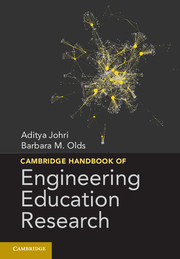Book contents
- Frontmatter
- Dedication
- Contents
- Editors
- Contributors
- Foreword
- Acknowledgments
- Introduction
- Chapter 1 Chronological and Ontological Development of Engineering Education as a Field of Scientific Inquiry
- Part 1 Engineering Thinking and Knowing
- Part 2 Engineering Learning Mechanisms and Approaches
- Part 3 Pathways into Diversity and Inclusiveness
- Part 4 Engineering Education and Institutional Practices
- Part 5 Research Methods and Assessment
- Part 6 Cross-Cutting Issues and Perspectives
- Chapter 30 Engineering Communication
- Chapter 31 Use of Information Technology in Engineering Education
- Chapter 32 Global and International Issues in Engineering Education
- Chapter 33 Engineering Ethics
- Chapter 34 The Normative Contents of Engineering Formation
- Chapter 35 Interdisciplinarity in Engineering Research and Learning
- Conclusion Engineering at the Crossroads
- Index
- References
Chapter 32 - Global and International Issues in Engineering Education
Published online by Cambridge University Press: 05 February 2015
- Frontmatter
- Dedication
- Contents
- Editors
- Contributors
- Foreword
- Acknowledgments
- Introduction
- Chapter 1 Chronological and Ontological Development of Engineering Education as a Field of Scientific Inquiry
- Part 1 Engineering Thinking and Knowing
- Part 2 Engineering Learning Mechanisms and Approaches
- Part 3 Pathways into Diversity and Inclusiveness
- Part 4 Engineering Education and Institutional Practices
- Part 5 Research Methods and Assessment
- Part 6 Cross-Cutting Issues and Perspectives
- Chapter 30 Engineering Communication
- Chapter 31 Use of Information Technology in Engineering Education
- Chapter 32 Global and International Issues in Engineering Education
- Chapter 33 Engineering Ethics
- Chapter 34 The Normative Contents of Engineering Formation
- Chapter 35 Interdisciplinarity in Engineering Research and Learning
- Conclusion Engineering at the Crossroads
- Index
- References
Summary
“There is an urgent need for research on engineering in a global context. The phenomenon of global engineering is still emerging. There is a need for a theoretical foundation on learning behaviors and models as well as on organizational processes and management methods focused on instilling global competence in engineers.”
Global Engineering Excellence Initiative (GEEI) Report (Italics in original, 2006, p. 2)Introduction
Although globalization has been a political and economic concern for centuries (O’Leary, Orlikowski, & Yates, 2002), its impact on the engineering education community has become particularly salient since the publication of the Engineer of 2020 (National Academy of Engineering [NAE], 2003) and The World Is Flat (Friedman, 2005). These and subsequent publications (Committee on Science Engineering and Public Policy [CSEPP], 2006; Duderstadt, 2008, Engineers Against Poverty (EAP)/Institute of Education (IOE), 2008; GEEI, 2006; Grandin & Hirleman, 2009; NAE, 2005) have emphasized the critical need to train globally competent engineers. Academics, practitioners, and policymakers alike have realized that solving the critical problems facing the world today, including addressing the NAE Grand Challenges (NAE, http://www.engineeringchallenges.org/) and achieving a “better quality of life,” will require close collaboration among engineers from around the world. Not surprisingly, educational institutions are investing millions of dollars to train students for success in the globalized economy through initiatives such as study abroad. Students, in turn, are spending significant amounts of money to participate in these programs. Recent efforts to pass a study abroad bill provide still another indication of the importance of this issue at the national level (Study Abroad Bill, 2009). And from a research perspective, the National Science Foundation (NSF) itself spends upwards of $50 million each year funding international programs (Office of International Science and Engineering [OISE], 2008).
The greatest investment by far, however, has been by industry. In 2011 alone, U.S. firms spent more than $156 billion on workforce training, an average of $1,182/employee (American Society for Training & Development [ASTD], 2012). Almost 21% of that amount was spent on training people to work more effectively with others, and global issues are becoming a bigger slice of that pie amidst growing recognition that global work experiences give a boost to industry careers. It is within this context that engineering educators are trying to make an impact to better prepare future engineers for the global world of work.
- Type
- Chapter
- Information
- Cambridge Handbook of Engineering Education Research , pp. 655 - 672Publisher: Cambridge University PressPrint publication year: 2014
References
- 16
- Cited by

